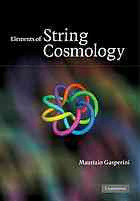Table Of ContentELEMENTS OF STRING COSMOLOGY
The standard cosmological picture of our Universe emerging from a “big bang”
leaves open many fundamental questions: Is the big bang a true physical singu-
larity? What happens to the Universe at ultra-high energy densities when even
gravityshouldbequantized?Hasourcosmologicalhistoryafiniteorinfinitepast
extension? Do we live in more than four space-time dimensions? String theory, a
unified theory of all forces of nature, should be able to answer these questions.
This book contains a pedagogical introduction to the basic notions of string
theory and cosmology. It describes the new possible scenarios suggested by
string theory for the primordial evolution of our Universe. It discusses the main
phenomenologicalconsequencesofthesescenarios,stressestheirdifferencesfrom
each other, and compares them with the more conventional models of inflation.
The first book dedicated to string cosmology, it summarizes over 15 years of
research in this field and introduces current advances. The book is self-contained
so it can be read by astrophysicists with no knowledge of string theory, and high-
energy physicists with little understanding of cosmology. Detailed and explicit
derivationsofalltheresultspresentedprovideadeeperappreciationofthesubject.
MAURIZIOGASPERINIisProfessorofTheoreticalPhysicsinthePhysicsDepartment
of the University of Bari, Italy. He has authored several publications on gravit-
ational theory, high-energy physics and cosmology, and has twice received one
of the Awards for Essays on Gravitation from the Gravity Research Foundation
(1996 and 1998).
ELEMENTS OF
STRING COSMOLOGY
MAURIZIO GASPERINI
UniversityofBari,Italy
CAMBRIDGEUNIVERSITY PRESS
Cambridge, New York, Melbourne, Madrid, Cape Town, Singapore, São Paulo
Cambridge University Press
The Edinburgh Building, Cambridge CB28RU, UK
Published in the United States of America by Cambridge University Press, New York
www.cambridge.org
Information on this title: www.cambridge.org/9780521868754
© M. Gasperini 2007
This publication is in copyright. Subject to statutory exception and to the provision of
relevant collective licensing agreements, no reproduction of any part may take place
without the written permission of Cambridge University Press.
First published in print format 2007
ISBN-13 978-0-511-33545-7 eBook (NetLibrary)
ISBN-10 0-511-33545-8 eBook (NetLibrary)
ISBN-13 978-0-521-86875-4 hardback
ISBN-10 0-521-86875-0 hardback
Cambridge University Press has no responsibility for the persistence or accuracy of urls
for external or third-party internet websites referred to in this publication, and does not
guarantee that any content on such websites is, or will remain, accurate or appropriate.
To Patty
with gratitude
Contents
Preface page xi
Acknowledgements xiii
Notation, units and conventions xiv
1 A short review of standard and inflationary cosmology 1
1.1 The standard cosmological model 1
1.2 The inflationary cosmological model 20
References 35
2 The basic string cosmology equations 37
2.1 Tree-level equations 38
2.2 The Einstein-frame representation 45
(cid:2)
2.3 First-order (cid:2) corrections 52
Appendix2A DifferentialformsinaRiemannianmanifold 64
References 70
3 Conformal invariance and string effective actions 71
3.1 Strings in curved backgrounds and conformal anomalies 72
3.2 Higher-curvature and higher-genus expansion 84
Appendix 3A The massless multiplet of the bosonic string in
Minkowski space 91
Appendix 3B Superstring models and effective actions 104
References 130
4 Duality symmetries and cosmological solutions 132
4.1 Scale-factor duality and the pre-big bang scenario 134
4.2 Duality with matter sources 142
4.3 Global O(d, d) symmetry 157
Appendix 4A A non-local, general-covariant dilaton potential 174
vii
viii Contents
Appendix 4B Examples of regular and self-dual solutions 181
References 192
5 Inflationary kinematics 194
5.1 Four different types of inflation 195
5.2 Dynamical equivalence of super-inflation and accelerated
contraction 198
5.3 Horizons and kinematics 202
References 209
6 The string phase 210
6.1 High-curvature fixed points of the string cosmology equations 213
6.2 Strong coupling corrections and the curvature “bounce” 223
6.3 String gas cosmology 231
Appendix 6A Birth of the Universe in quantum string cosmology 239
References 250
7 The cosmic background of relic gravitational waves 253
7.1 Propagation of tensor perturbations 254
7.2 Parametric amplification and spectral distribution 266
7.3 Expected relic gravitons from inflation 287
7.4 Sensitivities and cross-correlation of gravitational detectors 310
Appendix 7A Higher-derivative corrections to the tensor perturbation
equations 323
References 331
8 Scalar perturbations and the anisotropy of the CMB radiation 334
8.1 Scalar perturbations in a cosmological background 335
8.2 The anisotropy spectrum of the CMB radiation 362
8.3 Adiabatic metric perturbations from the string theory axion 389
Appendix 8A Photon–dilaton interactions and cosmic magnetic fields 408
Appendix 8B Seeds for the CMB anisotropy 416
References 424
9 Dilaton phenomenology 428
9.1 Spectral intensity of a massive dilaton background 429
9.2 Interaction with gravitational antennas 445
9.3 Dilaton dark energy and late-time acceleration 463
Appendix 9A The common mode of interferometric detectors 478
References 482
10 Elements of brane cosmology 484
10.1 Effective gravity on the brane 487
10.2 Warped geometry and localization of gravity 496
Contents ix
10.3 Brane-world cosmology 508
10.4 Ekpyrotic and cyclic scenario 523
10.5 Brane–antibrane inflation 533
References 545
Index 548

